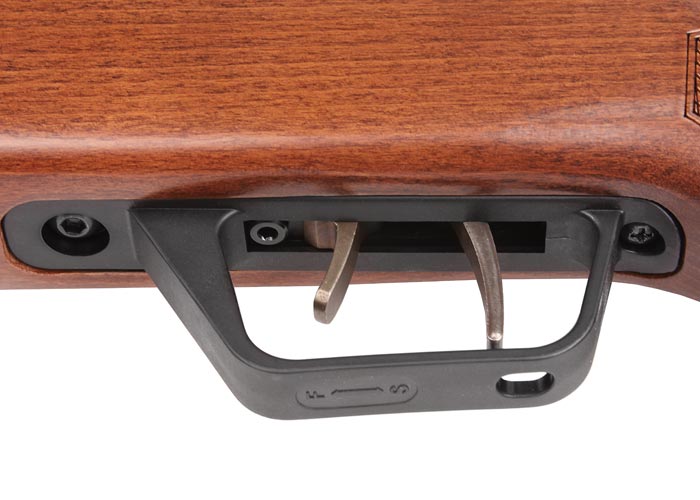A large part of trigger control is understanding how trigger creep can affect shooting accuracy and your gun’s overall performance. As a part of what is called the trigger pre-travel phase, trigger creep refers to the positive movement of the trigger that moves the sear and engages the mainspring of the gun. Though not necessarily negative, and a necessary part of a trigger to some extent, especially in a direct-sear trigger, trigger creep can result in a poor trigger pull, causing the shooter to miss their target by a large margin. Many shooters, when speaking about creep, refer to the gritty feeling a poor trigger can have. This is the rough or jerky feeling when pulling through the creep and makes shooting much less pleasant. To be able to fully recognize problematic creep with your guns, let’s break down the trigger creep definition and ways to address it for clean, crisp shooting.

Trigger Pre-Travel
The trigger pre-travel phase is comprised of three parts: trigger take-up, wall, and trigger creep. To get a better idea of this process, visualize an air gun or firearm in hand or grab yours (after completely unloading!) Also known as slack, the trigger take-up occurs when you’ve placed your trigger finger on the trigger, and you’ve begun to squeeze. When the positive movement hasn’t yet caused the sear to move or engaged the mainspring, that’s the take-up. In a two-stage trigger, this is the first stage. A single-stage trigger shouldn’t really have any slack or take-up. From there, you’ll hit the next step, which is the wall. You’ll have more resistance here, requiring more pressure from the trigger finger to keep it moving. The wall will begin to engage the sear as you pull on the trigger. It’s only after the wall that trigger creep comes into play. Creep makes the sear move and depending on your gun, you’ll feel “steps” as well. These can happen when the sear creeps and stops, demanding even more pressure applied to the trigger. The existence of these “steps” is referred to as trigger stacking, which is essentially anything that adds on the trigger resistance as you pull. Some shooters will take and polish the sears to remove these steps, but that is something that we recommend be undertaken by a qualified gunsmith as it is very easy to ruin the sears and take the gun out of commission.
Trigger Creep’s Effect on Accuracy
With trigger creep, the feeling is one of the trigger moving and pausing before the actual break. When you’re expecting consistent resistance up to this point, creep can really throw a wrench in how your shot goes. If you’ve used multiple airguns and powder burners, you’ve likely experienced this exact hiccup-like instance. What you really don’t want is a trigger with multiple instances of creep, as it will break the shooter’s focus on the target. For two-stage triggers, trigger creep occurs in the second stage when the sear is released.
The inaccuracy presented by trigger creep is a real issue that can easily thwart hunting sessions and target shooting. Even with perfect trigger finger placement, grip, and overall alignment, creep can undermine even the best of shooters. This is not to say that shooting well with a gun with trigger creep is impossible; many an operator has chosen to deal with considerable creep and, over time, gotten used to the quirks of it. While not necessarily ideal, most experienced airgun and firearm owners know how to handle creep.
Can Trigger Creep Be Eliminated?
Today, excessive trigger creep is mostly a non-issue, as airgunners and powder firearm owners can enlist the services of capable air gunsmiths and gunsmiths to remedy creep. To solve your gun’s creep problem, they’ll address the sear movement and the hammer of the gun. This is a safe bet if you’re unsure how to troubleshoot trigger creep on your own and would rather have a professional get it right the first time. If you’d rather attempt fixing it on your own, there are a few things you can do. Many have seen great results from simply polishing the trigger and hammer with high-quality metal polish. You can also take time to dry fire your airgun or powder shooter to see if you can smooth out the creep.
Rolling friction triggers are growing in popularity, which operate differently than traditional sliding friction triggers. These are designed to totally eradiate creep, providing a clean trigger pull and break every time. TriggerTech was the first to develop just a trigger, when Mats Lipowski and Greg Baniak created a prototype for a crossbow. Their “Zero Creep Technology” uses the lowest operational energy possible with a fixed level of engagement. New solutions to old problems like trigger creep are being brought to life by the folks that encounter them the most.
The Bottom Line on Trigger Creep
The trigger creep definition is one that is time and time again confused with trigger take-up, leading operators into even more confusion about their guns. Where the take-up phase does NOT move the sear or engage the mainspring, trigger creep DOES each of these. When you pull the trigger with complete control and it still doesn’t feel clean, you know you’ve got gritty creep. Whether you’ve got a single or two-stage trigger, grit in the creep is the last thing you want to deal with when you’re out at the range, hunting, or even just plinking in the backyard. Proper trigger control, from breathing and grip to trigger finger pressure, includes knowing how your trigger operates. By getting to know what the trigger creep definition really is, you’ll be able put a name to that stop and go feeling when you pull on your gun’s trigger. If you’re not 100% certain you can troubleshoot your air gun or traditional firearm on your own, consult a professional air gunsmith or gunsmith to help you get the most out of your gun.